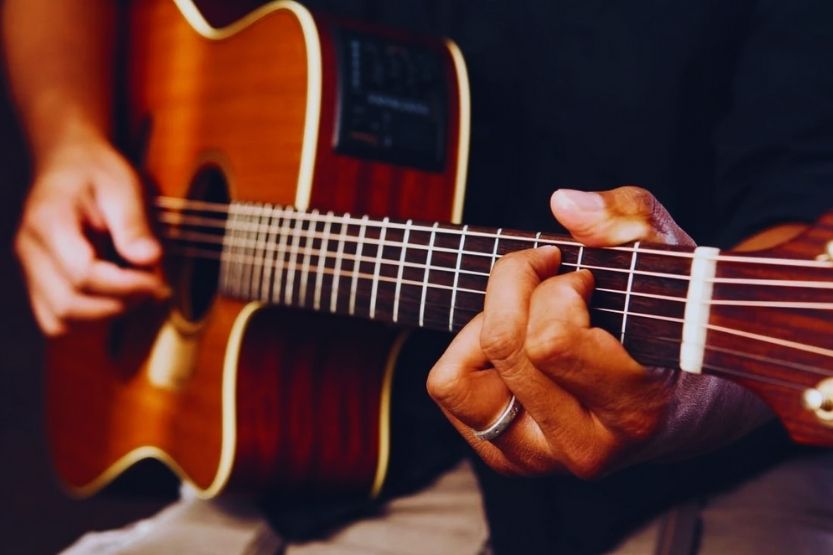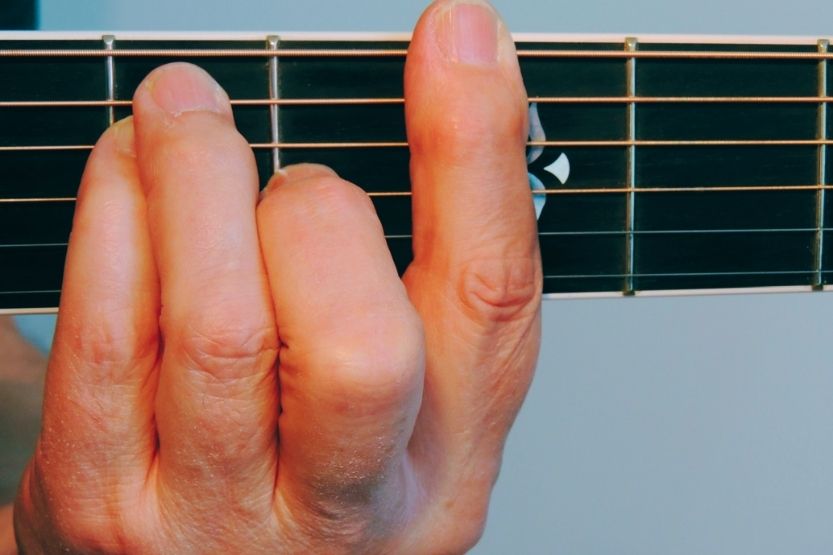Playing guitar is intimidating for newbies. You need to learn a lot, and once you are ready to advance to more difficult positions, you must know how to play barre chords. It requires holding all the strings, which is what makes it challenging for a newbie.
Learning the proper techniques makes it easier and more comfortable to play barre chords, reducing pressure and strain. Here’s a guide on how you can play barre chords like a pro:
- Position your thumb on the neck
- Press your index finger on a fret
- Tuck your elbows
- Straighten your index finger
- Avoid bending your wrist
Read on to learn more about how to play barre chords, including the fundamental techniques and tips to make it easier.
What Is a Barre Chord?

Most Essential Chords for Guitar Players to Learn
The barre chord is one of the essential chords guitar players should learn, even if it is quite difficult. You will use it when playing 90% of the chords. From funk and soul to rock ‘n roll, the barre chord is a vital musical skill to master.
Method of Playing
Barre is a French word that describes a method of playing wherein you use a single finger for pressing multiple chords. When playing the barre chord, your index finger bars five to six strings of a similar fret, like making a new nut.
It is based on the E major and E minor chords when using six strings. On the other hand, if you use only five strings, the basis would be A major and A minor.
If you are new to guitar playing, the first thing you will learn is open chords. They use a guitar’s first three frets. The exact opposite of such is playing the barre chords.
What Are the Notes of D# Major?
How to Play Barre Chords
It can be overwhelming at first, but with time and patience, you will eventually get better. Here’s a quick guide in playing barre chords:
1. Position Your Thumb on the Neck
Start by getting comfortable with your position. Position your thumb lower and halfway on the neck of the guitar. You cannot play the barre chord if you place your thumb too high or wrap it around too much.
A good position has the thumb at almost the same line as your index finger. Alternatively, it should be between the ring and index fingers.
2. Press Your Index Finger on a Fret
With your thumb now in position, the next you must work on is your index finger. Do not use your index finger’s flat face. Applying pressure can be challenging because it is soft. Additionally, strings can tangle on the grooves, which will make it harder for you to concentrate playing.
You should use your index finger’s edge. This is the part with a bone. This way, you can apply minimal pressure.
3. Tuck Your Elbows
Once you secure the position of your fingers, pay attention to your elbow. Keeping it close and tucked into your body will make it easier to put your fingers on the fretboard. Hang your arm without being too tight or too loose.
4. Straighten Your Index Finger
Chances are, you cannot hear some chords, especially when you are playing D or G string. An easy solution is to fix the position of your index finger. Straightening it up is an excellent quick fix.
Even a slight arch would mean minimal pressure on the middle strings, and most of the force is on the outer strings. The best way to avoid this is to keep your index finger straight and flat.
5. Avoid Bending Your Wrist
As you play barre chords, your wrist should have minimal movements. More so, you should not press your palm against the guitar’s neck. Make sure that there is sufficient space between the neck and your palm. Imagine holding a hamburger in your hand.
Playing Different Barre Chords

Now that you know the fundamental steps, this section briefly talks about some of the most important and common barre chords that you can play.
1. G Major Barre Chord
- Bar the string on the third fret using your first finger
- Put your second finger on the fourth fret or third string
- Press your third finger on the fifth fret or fifth string
- Put your fourth finger on the fifth fret or fourth string
2. A Major Barre Chord
- Bar the string on the fifth fret using your first finger
- Put your second finger on the sixth fret or third string
- Press your third finger on the seventh fret or fifth string
- Put your fourth finger on the seventh fret or fourth string
3. A Major 7 Barre Chord
- Bar the string on the fifth fret using your first finger
- Put your second finger on the sixth fret or third string
- Press your third finger on the seventh fret or fourth string
- Put your fourth finger on the seventh fret or second string
4. D Major Barre Chord
- Bar the string on the tenth fret using your first finger
- Put your second finger on the 11th fret or third string
- Press your third finger on the 12th fret or fifth string
- Put your fourth finger on the 12th fret or fourth string
5. D Minor Barre Chord
- Bar the string on the fifth fret using your first finger
- Put your second finger on the second fret and sixth string
- Press your third finger on the seventh fret and third string
- Put your fourth finger on the seventh fret and third string
Training Exercises for Playing Better Barre Chords
Practice makes perfect, even when playing the barre chord. With this, below are some of the best exercises that will help make you better. These exercises will help work on your finger strength:
1. Improve Muscle Memory
The trick is to familiarize your hand with the movements, which will make it more natural every time you are playing. Practice lifting a finger and re-applying pressure. Add and minimize pressure as you move. This exercise is like a push-up for your fingers. You won’t immediately see progress, so make sure to pack a lot of patience.
2. Use Your Index Fingers to Slap the Strings
With your pinky, middle, and ring fingers in position, use your middle finger for slapping the low E string four times. Pick each string and repeat playing. Next, use your index finger for slapping the higher strings. Play them once again by picking the strings individually. Go one fret down and repeat slapping until the first fret. It will help in achieving a clearer sound.
3. Practice Changing from Major to Minor
Switching from major to minor can be tricky when playing barre chords, which is why it is another exercise you should work on. Go back and forth on the same frets so that you can train your fingers to transition from one position to another smoothly. In time, it will be easier to move from major to minor chords.
4. Monitor Your Progress
Monitoring your progress is an important part of the exercise to train your fingers. This way, you will know how well or poorly you are doing. If the exercises are not proving to be sufficient, exert double the effort. Do not lose hope, as you can get better in time if you practice more diligently.
Tips and Tricks for Playing the Barre Chords

Now that you know the basics of playing the barre chords, this section lists down some of the tips that can help you turn into a pro:
1. Avoid Strain on Your Wrist
The wrong hand position can over-strain your wrist. This makes it more difficult to hold the guitar properly. To avoid unnecessary pressure, lower your elbow and shoulders, making sure you relax. Do not bend or move your wrist too forward. A slight tilt of the guitar upwards is also an effective solution to avoid putting too much wrist strain.
2. Apply Proper Pressure
Speaking of avoiding strain, it is also vital to practice applying the right pressure. Applying too much will make you uncomfortable. Meanwhile, using a pressure that is too light will make you unable to play the necessary chord. Work towards maintaining even pressure on all your fingers.
3. Use Your Shoulder for Support
It is not just your finger position that you should be mindful of. Pay attention to how you position your body, especially in terms of using your shoulder as support. Pull your shoulder back and down. Meanwhile, relax your elbow, allowing it to fall with gravity. In turn, it will also let you exert less tension on your wrist and hand.
4. Pick the Right Guitar
Playing barre chords is not just about the right technique. The guitar that you are using also has a major influence. That said, one thing that you should look at is the neck shape. We recommend a C or modern C neck. It is not as bulky as others, so you can be more comfortable positioning your fingers.
A short scale length is also a must. With the latter, there is a minimal distance between the bridge and the nut. This means that a smaller space exists between the frets. Stretching your fingers will be easier, especially if you have a small hand.
It also helps to choose a guitar with large frets. When they are tall, you don’t need to exert too much effort when pressing. It lessens the strain on your wrist, which will make you more comfortable as well.
5. Change the Strings
If you are uncomfortable playing with your current guitar, this does not instantly mean that you should buy a new one. Among others, a good fix is to switch to lighter strings. This way, they will make it easier to position your fingers on the fretboard while minimizing the potential strain.
Songs to Play on Barre Chords
As we end this guide, we’ll list down some of the best songs that you can practice in barre chords:
- Let It Be by The Beatles
- Wild Horses by The Rolling Stones
- Stay with Me by Sam Smith
- Demons by Imagine Dragons
- No Woman, No Cry by Bob Marley
- Creep by Radiohead
- Use Somebody by Kings of Leon
- I’m Yours by Jason Mraz
- Rolling in the Deep by Adele
- Titanium by David Guetta
Conclusion – How to Play Barre Chords
As a newbie, playing the barre chords is one of the most challenging in a guitar. It requires pressing your index finger on multiple strings, which can be confusing and uncomfortable for beginners. To do it properly, you should master the proper positioning of your thumb and index finger, as well as your elbow.
To improve your skills in playing barre chords, practice how to minimize the strain on your wrist. It also involves finding the right pressure, which should not be too light or hard when pressing the frets. Using the right guitar and picking light strings will also help.
Related reading:
How Many Strings Does a Bass Guitar Have?
How Many Strings Does a Guitar Have?
How Many Guitar Chords Are There?
Drop C Tuning – What Is It and How to Tune a Guitar to Drop C







![Read more about the article Best Way to Learn Guitar [12 Tips for Learning Acoustic or Electric Guitar]](https://musicalinstrumentpro.com/wp-content/uploads/2020/11/best-way-to-learn-guitar-on-your-own-300x200.jpg)

